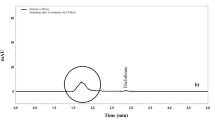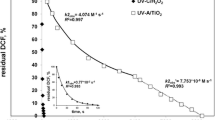Abstract
In this study, the photolysis behavior of commonly used anti-inflammatory drug diclofenac (DCF) was investigated using UV-C and UV-A irradiation. In that purpose, DCF conversion kinetics, mineralization of organic content, biodegradability, and toxicity were monitored and compared. The results showed different kinetics of DCF conversion regarding the type of UV source applied. However, in both cases, the mineralization extent reached upon complete DCF conversion is rather low (≤10 %), suggesting that the majority of DCF was transformed into by-products. Formation/degradation of main degradation by-products was monitored using high-performance liquid chromatography–electrospray ionization-tandem mass spectrometry (HPLC–ESI-MS/MS), whereas different profiles were obtained by UV-C and UV-A photolysis. The results of bioassays revealed that biodegradability of DCF solutions remained low through the applied treatments. The toxicity of irradiated DCF solutions was evaluated using Vibrio fischeri. A significant reduction of toxicity, especially in the case of UV-A radiation, was observed upon complete degradation of DCF. In addition to toxicity reduction, calculated Log K OW values of DCF degradation by-products indicate their low potential for bioaccumulation (Log K OW ≤ 3) in comparison to the parent substance.







Similar content being viewed by others
References
Agüera A, Pérez Estrada LA, Ferrer I, Thurman EM, Malato S, Fernández-Alba AR (2005) Application of time-of-flight mass spectrometry to the analysis of phototransformation products of diclofenac in water under natural sunlight. J Mass Spectrom 40:908–915
Alnaizy R, Akgerman A (2000) Advanced oxidation of phenolic compounds. Adv Environ Res 4(3):233–244
Bartels P, von Tümpling W (2007) Solar radiation influence on the decomposition process of diclofenac in surface waters. Sci Total Environ 374:143–155
Beltran FJ (2003) Ozone-UV radiation-hydrogen peroxide oxidation technologies. In: Tarr MA (ed) Chemical degradation methods for wastes and pollutants, environmental and industrial applications. Marcel Dekker Inc, USA, pp 1–77
Brausch JM, Connors KA, Brooks BW, Rand GM (2010) Human pharmaceuticals in the aquatic environment: a review of recent toxicological studies and considerations for toxicity testing. In: Whitacre DM (ed) Reviews of environmental contamination and toxicology, vol 218. Springer, Germany, pp 1–99
Calza P, Massolino C, Pelizzetti E (2008a) Photo-induced transformation of hexaconazole and dimethomorph over TiO2 suspension. J Photochem Photobiol, A 200:356–363
Calza P, Massolino C, Pelizzetti E, Minero C (2008b) Solar driven production of toxic halogenated and nitroaromatic compounds in natural seawater. Sci Total Environ 398(1-3):196–202
Carballa M, Omil F, Lema JM, Llompart M, García-Jares C, Rodríguez I, Gómez M, Ternes T (2004) Behavior of pharmaceuticals, cosmetics and hormones in a sewage treatment plant. Water Res 38:2918–2926
Cleuvers M (2004) Mixture toxicity of the anti-inflammatory drugs diclofenac, ibuprofen, naproxen, and acetylsalicylic acid. Ecotoxicol Environ Saf 59:309–315
Corcoran J, Winter MJ, Tyler CR (2010) Pharmaceuticals in the aquatic environment: a critical review of the evidence for health effects in fish. Crit Rev Toxicol 40(4):287–304
EEC (1993) Commission Directive 93/67/EEC of 20 July 1993 laying down the principles for the assessment of risks to man and the environment of substances notified in accordance with Council Directive 67/548/EEC. Off J Eur Communities 227:9–17
Eggen T, Vogelsang C (2015) Occurrence and fate of pharmaceuticals and personal care products in wastewater. Compr Anal Chem 67:245–294
Eriksson J, Svanfelt J, Kronberg L (2010) A photochemical study of diclofenac and its major transformation products. Photochem Photobiol 86:528–532
EU (2013) Directive 2013/39/EU of the European Parliament and of the Council amending Directives 2000/60/EC and 2008/105/EC as regards priority substances in the field of water policy. Off J Eur Communities 226:1–17
Gavrilescu M, Demnerová K, Aamand J, Agathos S, Fava F (2015) Emerging pollutants in the environment: present and future challenges in biomonitoring, ecological risks and bioremediation. New Biotechnol 32:147–156
Gimeno O, Carbajo M, Beltran FJ, Rivas FJ (2005) Phenol and substituted phenols AOPs remediation. J Hazard Mater B119:99–108
Gros M, Petrovic M, Ginebreda A, Barceló D (2010) Removal of pharmaceuticals during wastewater treatment and environmental risk assessment using hazard index. Environ Int 36:15–26
Global Water Research Coalition (GWRC) (2004) Pharmaceuticals and personal care products in the water cycle. An international review, London, United Kingdom
Juretic D, Kusic H, Dionysiou DD, Loncaric Bozic A (2013) Environmental aspects of photooxidative treatment of phenolic compounds. J Hazard Mater 262:377–386
Keen OS, Thurman EM, Ferrer I, Dotson AD, Linden KG (2013) Dimer formation during UV photolysis of diclofenac. Chemosphere 93:1948–1956
Krebel M, Kusic H, Koprivanac N, Meixner J, Loncaric Bozic A (2011) Treatment of chlorophenols by UV-based processes: correlation of oxidation by-products, wastewater parameters and toxicity. J Environ Eng 137(7):639–649
Kuhn HJ, Braslavsky SE, Schmidt R (2004) Chemical actinometry, IUPAC technical report. Pure Appl Chem 76(12):2105–2146
Kümmerer K (2008) Pharmaceuticals in the environment: sources, fate, effects and risks. Springer, Germany
Liu J, Lu G, Xie Z, Zhang Z, Li S, Yan Z (2015) Occurrence, bioaccumulation and risk assessment of lipophilic pharmaceutically active compounds in the downstream rivers of sewage treatment plants. Sci Total Environ 511:54–62
Manini P, Napolitano A, Westerhof W, Riley PA, d’Ischia M (2009) A reactive ortho-quinone generated by tyrosinase-catalyzed oxidation of the skin depigmenting agent monobenzone: self-coupling and thiol-conjugation reactions and possible implications for melanocyte toxicity. Chem Res Toxicol 22(8):1398–1405
Meffe R, de Bustamante I (2014) Emerging organic contaminants in surface water and groundwater: a first overview of the situation in Italy. Sci Total Environ 481:280–295
Memmert U, Peither A, Burri R, Weber K, Schmidt T (2013) Diclofenac: new data on chronic toxicity and bioconcentration in fish. Environ Toxicol Chem 32(2):442–452
Milovac N, Juretic D, Kusic H, Dermadi J, Loncaric Bozic A (2014) Photooxidative degradation of aromatic carboxylic acids in water; influence of hydroxyl substituents. Ind Eng Chem Res 53(26):10590–10598
Nicole I, De Laat J, Dore M, Duguet JP, Bonnnel C (1990) Utilisation du rayonnement ultraviolet dans le traitement des eaux: mesure du flux photonique par actinometrie chimique au peroxyde d’hydrogene: Use of U.V. radiation in water treatment: measurement of photonic flux by hydrogen peroxide actinometry. Water Res 24(2):157–168
Onesios KM, Yu JT, Bower EJ (2009) Biodegradation and removal of pharma-ceuticals and personal care products in treatment systems: a review. Biodegradation 20:441–466
Postigo C, Barceló D (2015) Synthetic organic compounds and their transformation products in groundwater: occurrence, fate and mitigation. Sci Total Environ 503–504:32–47
Schulze T, Weiss S, Schymanski E, von der Ohe PC, Schmitt-Jansen M, Altenburger R, Streck G, Brack W (2010) Identification of a phytotoxic photo-transformation product of diclofenac using effect-directed analysis. Environ Poll 158:1461–1466
Stülten D, Zühlke S, Lamshöft M, Spiteller M (2008) Occurrence of diclofenac and selected metabolites in sewage effluents. Sci Total Environ 405:310–316
Tixier C, Singer HP, Oellers S, Müller SR (2003) Occurrence and fate of carmazepine, clofibricacid, diclofenac, ibuprofen, ketoprofen and naproxen in surface waters. Environ Sci Technol 37:1061–1068
Verlicchi P, Al Aukidya M, Zambelloa E (2015) What have we learned from worldwide experiences on the management and treatment of hospital effluent?—an overview and a discussion on perspectives. Sci Total Environ 514:467–491
Virkutyute J, Varma RS, Jeatheesan V (2010) Treatment of micropollutants in water and wastewater. IWA Publishing, London
Wols BA, Hofman-Caris CH (2012) Review of photochemical reaction constants of organic micropollutants required for UV advanced oxidation processes in water. Water Res 46(9):2815–2827
Zhang Y, Geißen SU, Gal C (2008) Carbamazepine and diclofenac: removal in wastewater treatment plants and occurrence in water bodies. Chemosphere 73:1151–1161
Acknowledgments
We gratefully acknowledge on the financial support from Croatian Science Foundation through projects entitled Environmental Implications of the Application of Nanomaterials in Water Purification Technologies (NanoWaP) (UIP-11-2013-7900) and Fate of pharmaceuticals in the environment and during advanced wastewater treatment (PharmaFate) (IP-09-2014-2353).
Author information
Authors and Affiliations
Corresponding authors
Additional information
Responsible editor: Hongwen Sun
Rights and permissions
About this article
Cite this article
Kovacic, M., Juretic Perisic, D., Biosic, M. et al. UV photolysis of diclofenac in water; kinetics, degradation pathway and environmental aspects. Environ Sci Pollut Res 23, 14908–14917 (2016). https://doi.org/10.1007/s11356-016-6580-x
Received:
Accepted:
Published:
Issue Date:
DOI: https://doi.org/10.1007/s11356-016-6580-x




